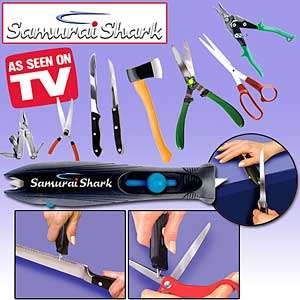We tested the claims of one late night As Seen On TV tool to sharpen blunt blades galore. The results? Not so sharp. The Claim
"The ultimate sharpening tool" puts a razor's edge on everything from dull blades, knives, scissors to workshop tools.
The Test
After test cuts with dull scissors and knife blades, we measured the improvement in cut speed and ease after sharpening with the Samurai Shark. The test included a before and after attempt at slicing a dish sponge, as the ad demonstrated.
The Verdict
Although the Shark improved cut speed, its design limitations caused knife blade damage and potentially put the consumer at risk. A predetermined bevel limits the types of blades that can be easily sharpened, forcing a freehand sharpening process that most amateurs would prefer to avoid.
Details
The on-camera talent cuts the sponge at about 36 seconds in to the ad for the
Samurai Shark, an infomercial wowfest in which Billy Mays puts a gleaming edge on all manner of blades, shears, loppers and knives.
First, a knife is shown to be too dull to cut an ordinary dish sponge. With just a few passes through the Samurai Shark's patented tungsten carbide groove, the knife pares the porifera as the scream-over exclaims, it's as easy as one, two, three!
The truth is, it is that easy. We sliced my own sponge this morning—and folks, that knife was far too dull to sever the SOS before the SS treatment. A brittle tungsten carbide abrasive, as explained by master sharpener Darryl Hoffman of
The Knife Guys, works best "when you have absolutely no other means of sharpening the knife." Hoffman's firm, which hones the finest of Denver's culinary cutlery with mostly aluminum oxide and the occasional zirconium or diamond, describes tungsten carbide's abrasion as a gradual tearing away of the blade. The process leaves a ragged, jagged edge, and "it'll cut, but not the way a knife is supposed to."
He says blades need a new edge once a year, using a professional service to grind a new bevel and restore the blade's rocking camber motion. Between annual tune-ups, you only have to hone your blades with a pass on each side from that steel rod sitting in your knife rack. As for reputable sharpeners, he says every city has at least a few, but warns to "beware the ones that just say they'll 'hollow-grind.'"
The Shark is not the first to jump the shark on this whole tungsten carbide thing.
Smith's 10-Second knife and scissors sharpener, a less expensive option, has a carbide blade ergonomically tilted at an angle, and a helpful knuckle-guard.
The Shark does not have a knuckle guard, and we feared that it would be sending a sharp blade towards us as we used it to chew up a few chisels and tin snips in our shed. But the Shark's biggest flaw isn't its lack of knuckle-guard—you can learn to live with that—it's the fact that that V-groove of tungsten carbide blades will only grind your blades at one specific bevel.
Hoffman said the sweet spot on bevels falls between 17 and 22 degrees, and this groove probably sits somewhere in that range, but it's certainly not right for every knife. For the misfits—scissors, axes and many of the other products the Shark says it'll sharpen—you have to use the tool's nubby kernel of carbide no bigger than an Xacto knife blade. It takes a steady hand and a steel nerve to drag this microscopic shark tooth along a blade it's tearing to shiny shreds. Maybe this is where the Samurai part kicks in. In general, big blades are best handled sharpening stone, like the puck-shaped
Edge Eater. The same little bit of carbide is your weapon against a serrated blade, and it works with the same partial efficacy. It is not the "world's only" serrated-blade sharpener that the infomercial claims it is—
saw files, hello?
In the end, as Hoffman tells his customers, a basic tungsten sharpener will suffice if you have absolutely no other way of getting an edge. "It's safer to use a knife that's badly sharpened as opposed to a dull one," he says.





